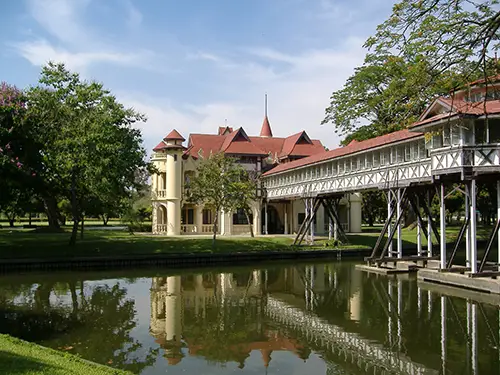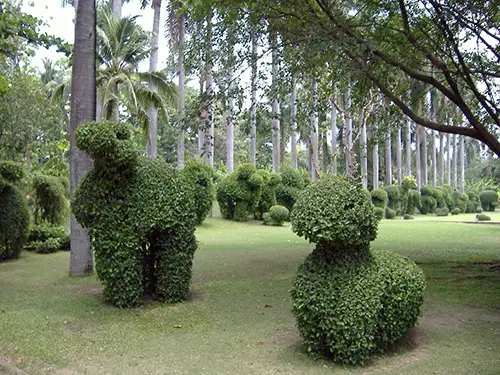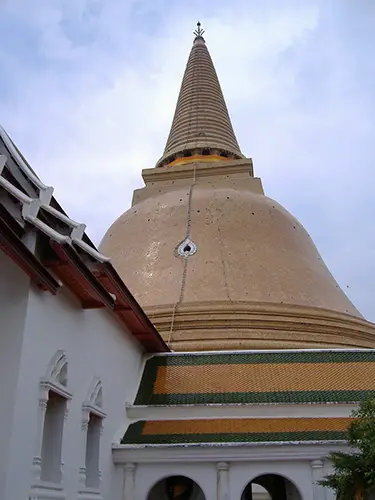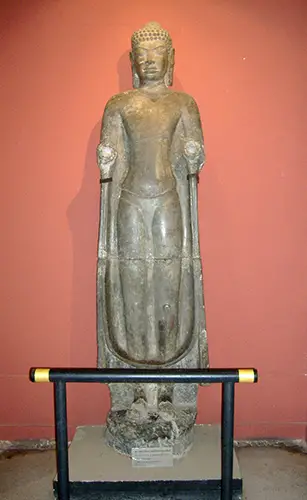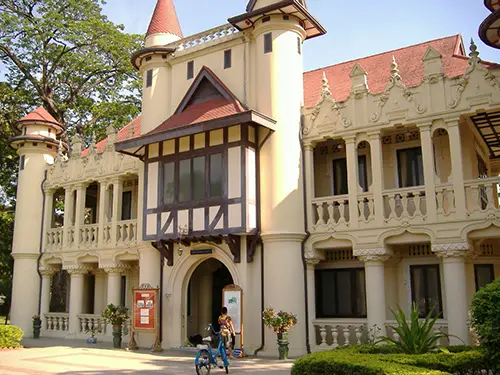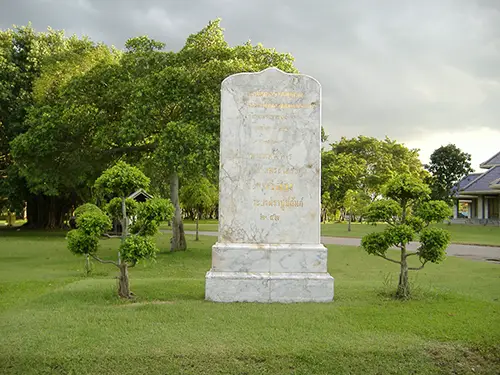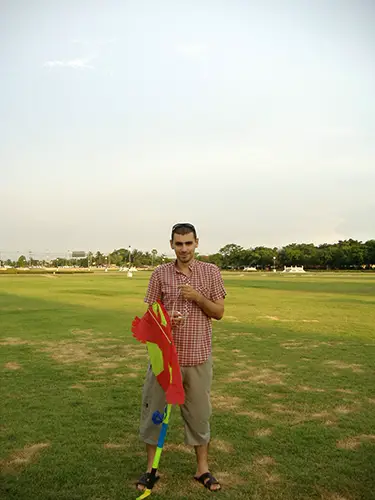There are truly many old and ancient things and places to experience and visit in Thailand, but when it comes to the ultimate “old destination” the Kingdom has to offer, few know that Nakhon Pathom is the place to go. A one-day trip to this relatively quiet and off the radar province can bring unexpected pleasures, with visits to cultural centers, temples, museums, palaces, and religious parks.
Located 56 km northeast of Bangkok, Nakhon Pathom is a small province with a history that goes back to the dawn of Thai civilization. Archeologists have unearthed here artifacts from the Dvaravati kingdom, a pre-Thai civilization that flourished from the 6th to the 11th century. It’s not surprising then that, the name of the province in Pali, Nagara Pathama, actually translates as “first city” and thus, Nakhon Pathom is often referred to as the oldest city in Thailand.
This in itself makes the province a worthwhile travel destinations but, on your next trip to Nakhon Pathom, make sure you don’t miss the following five must-visit destinations: The Rose Garden, Phra Pathom Chedi, Phra Pathom Chedi National Museum, Sanam Chan Palace, and Phutthamonthon Park. Forget about your daily chores and problems and immerse yourself in ancient Thai history and culture while taking advantage of refreshing air and manicured gardens.
- The Rose Garden
The administrative boundary between Bangkok and Nakhon Pathom is very clear but, as the capital expanded under it’s ever increasing population, Bangkok seems to have sprawled into Nakhon Pathom. As a result, many people living on Phetkasem Road, at the border of the two provinces, often claim to be Bangkokians but have a postal address belonging to Nakhon Pathom!
You’ll find your first destination on this major connecting road in Sam Phran District, not too far from the main road. Located next to Nakon Chaisi River, a tributary of the Chao Phraya River, the Rose Garden is the perfect place to unwind from the cacophony of noises you’ve just left behind in Bangkok. Although it’s not a botanical garden as the name suggests, the Rose Garden is more of a cultural village which does include numerous floral displays, but also has an all-inclusive show which boasts folk dancing, Thai boxing, sword fighting, and the customary elephant show.
The Rose Garden is open every day 8 am to 6 pm and the entry fee is 10 baht for adults and 5 baht for children. The admission to the show is separate and costs 300 baht. If this is your first contact with Thai culture, then it’s worth the investment.
- Phra Pathom Chedi
Continue your journey on Phetkasem Road until you enter Nakhon Pathom city proper, where the road signs will guide you to the imposing Phra Pathom Chedi, the silhouette of which you can also see on the 5 satang coin and on the seal of Nakhon Pathom province. Belonging to Wat Phra Pathommachedi Ratcha Wora Maha Wihan Temple, the chedi, standing at 120.5 meters height, is the world’s tallest stupa.
The name Phra Pathom Chedi, which translates as “the first holy stupa,” was chosen by King Mongkut (Rama 4), but historians now agree that the original historical stupa (now completely restored) was actually not the oldest nor the first stupa ever built in Southeast Asia.
The stupa itself and the surrounding temple complex present an abundance of archeological and architectural clues to the Dvaravati period but it is best if you just enjoy the site for what is, without getting bogged down in identifying each and every element of the temple.
- Phra Pathom Chedi National Museum
Right next to the stupa you’ll find Phra Pathom Chedi National Museum, one of the 38 branches of the National Museum where, in their air-conditioned rooms, you’ll be able to better understand the importance of the Dvaravati culture and also place it in the social, cultural, political, and religious context of the 6th to 11th centuries.
The grounds surrounding the museum display archeological remains of times passed by while the inside of the museum contains better preserved standing Buddha statuettes and Buddha heads that have survived intact over the centuries.
- Sanam Chan Palace
Only one kilometer away from the stupa, you’ll get a chance to move forth in the history of Thailand by visiting Sanam Chan Palace, a complex built by King Vajiravudh (Rama VI). Although the site now houses one provincial campus of Silapakorn University, it is still open to public especially that it also contains the King Rama VI Museum.
There are five building you can visit plus a shrine of Ganesh, the elephant-headed Hindu god. The buildings had been well resorted and give the visitors a glimpse into the influences Siam underwent in the late 19th century and early 20th century. There are Thai-style residences built on stilts and made entirely of wood, as well as buildings with the typical ornate Thai roofs and window frames which look more like a temple than a residence.
Western influences are seen in the colonial-style mansions with spacious rooms and verandas, plus an amazing small castle-like structure with mini-towers built in a combination of French and English styles. A statue of Yah Leh, King Rama VI’s furry dog “protects” the entrance to the castle.
- Phutthamonthon Park
Your last destination for the day is located on Phutthamonthon Sai 4 Road, right at the boundary between Nakhon Pathom province and Bangkok. So, practically, on your way back to Bangkok, turn right at the intersection of Petkasem and Sai 4 Roads and drive for a few more kilometers up the road. You won’t be disappointed for this small detour.
The park covers a huge area of 400 rai and is designated as a Buddhist park. Apart from spacious lawn areas, manicured bushes, and a few religious buildings, at almost 16m height, the park also boasts the highest free-standing Buddha statue in the world. The statue was designed by Corrado Feroci, known in Thailand by his naturalized name of Silipa Bhirasri, who also sculpted or designed other important monuments in Bangkok.
Apart from its religious role and significance, the park attracts many people who are just looking for a clean place to exercise out in the open. It is also a great location for flying kites and letting young children run around without worrying too much about getting hurt. (It is though good though to keep in mind that the park has seen some recent religious and political demonstrations and that there’s a strong army presence in the area.)
Due to its close proximity to Bangkok, getting to Nakhon Pathom is very straightforward. Busses leave regularly from the Southern Bus Terminal and vans from Victory Monument. You can also take the regular train and disembark right in front of Phra Pathom Chedi. You can also take the BTS skytrain on the green Silom line all the way to the end of the line at Bang Wa Station and from there continue your journey by bus up on Petkasem Road. Follow the same road if you drive your own car or motorbike. All five destinations recommended above are easy to find by just following the public road signs.
